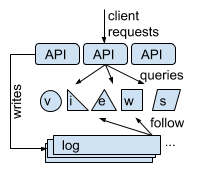| Ebay Open Sources Beam |
| Written by Alex Denham | |||
| Friday, 10 May 2019 | |||
|
eBay has made its distributed knowledge graph store open source. Beam can be used to store RDF-like data and supports SPARQL-like querying. It uses Apache Kafka for storage. Beam was largely written in Go. Knowledge graph stores are designed for modeling data that is highly interconnected. In a knowledge graph, data is represented as a single table of facts, where each fact has a subject, predicate, and object.Beam uses an RDF-like representation for data and a SPARQL-like query language.
Beam is distributed because it is designed to store large graphs that are too large to fit on a single server. It scales out horizontally to support higher query rates and larger data sets. The developers say that while its write rates don't scale, a typical Beam deployment should still be able to support tens of thousands of changes per second. Ebay has run a 20-server deployment of Beam for development purposes for about a year, which has been loaded with a dataset of about 2.5 billion facts, and which hasn't pushed Beam to its limits. Beam's architecture is based around a central log. All write requests are added to an append-only central log. The log is a network service that is internally replicated for fault-tolerance. Several view servers read the log and apply its entries in sequence. Different view servers maintain different states. An API tier accepts requests from clients. It appends the write requests to the log, and it collects data from the view servers to answer reads.
Apache Kafka is used for the log, and the view is implemented as a DiskView, which can run in two modes: either indexing knowledge graph facts by subject-predicate or by predicate-object. A typical deployment will run three replicas of multiple partitions of each mode. The DiskViews store their facts in RocksDB. There's also an API server that contains a query processor. This implements a query language that's similar to a subset of SPARQL. It consists of a parser, a cost-based query planner, and a parallel execution engine. The parser transforms an initial set of query lines into an abstract syntax tree (AST). The planner combines the AST with statistics about the data to find an efficient query plan. The executor then runs the plan, using batching and streaming throughout for high performance. Beam has been made open source because the team at Ebay can't continue working on it full-time to turn it into a finished production-ready system. The developers say Beam is ready to be used for offline, noncritical, or research applications today. It also has a number of internal packages that may be useful in other projects, such as its fanout and query planner modules. Beam is now available on GitHub.
|
Apple Updates Developer Tools 16/06/2025 Apple has announced a range of improvements to its developer tools at this year's WWDC (WorldWide Developers Conference), including a new foundation models framework and updates to Xcode, Apple's [ ... ] |
.NET Preview 5 Improves C# 16/06/2025 .NET 10 Preview 5 has been released with enhancements to C# 14 and additions to the Post-Quantum Cryptography (PQC) library. The .NET runtime has also been improved. |
More News
|
Comments
or email your comment to: comments@i-programmer.info




